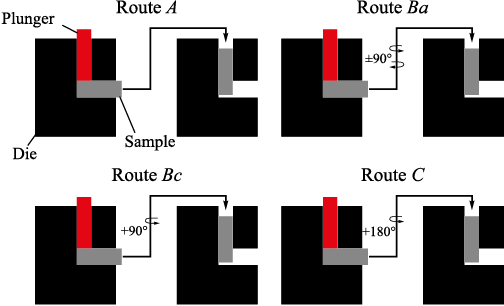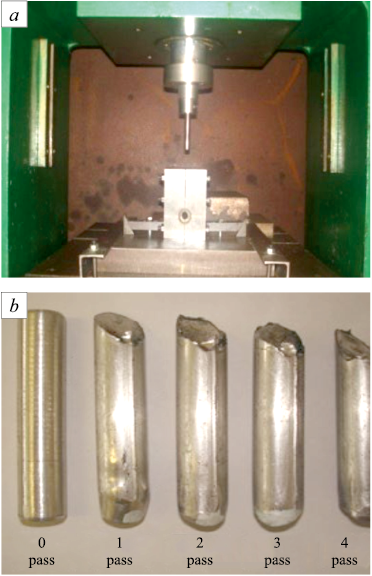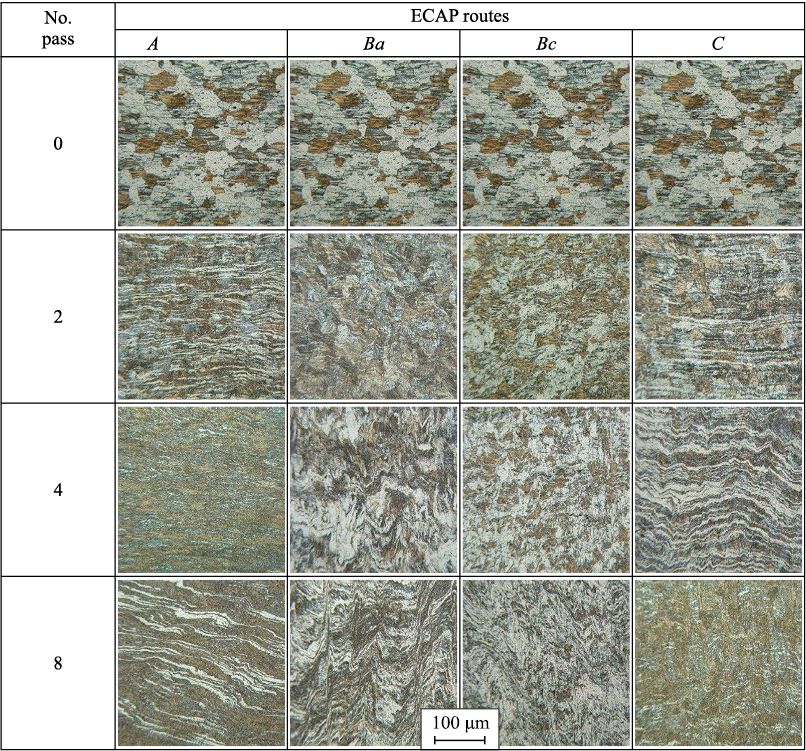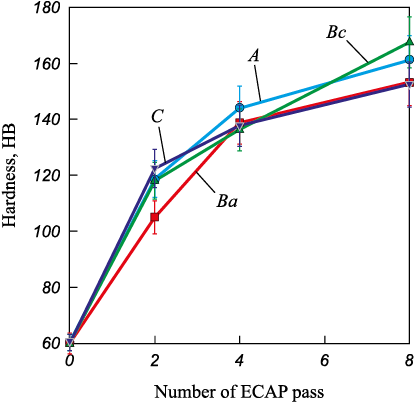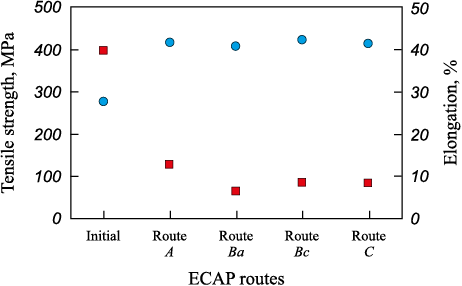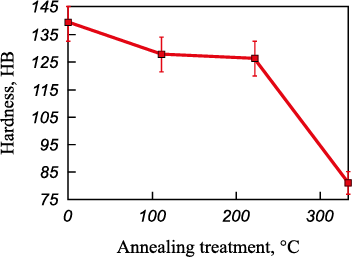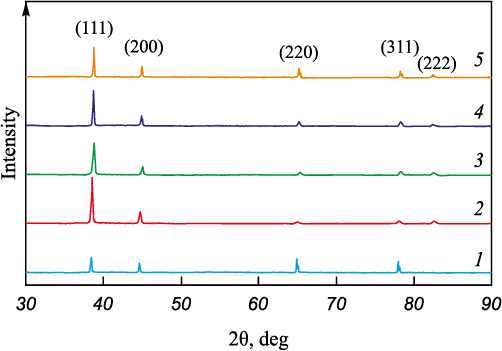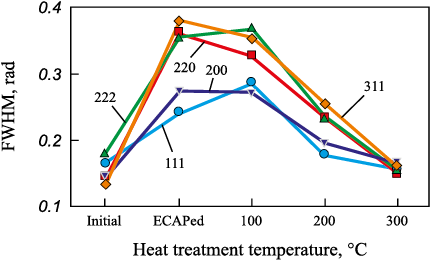Scroll to:
Mechanical properties and microstructure of Al–Mg (5052) alloy processed by equal-channel angular pressing (ECAP) with variation of ECAP routes and heat treatment
https://doi.org/10.17073/0368-0797-2024-1-37-46
Abstract
Equal-Channel Angular Pressing (ECAP) has become an effective technique of severe plastic deformation designed to produce ultrafine grain metals with improved mechanical properties, such as a good combination of strength and ductility. A report on the effect of ECAP routes on the mechanical and microstructure of commercial 5052 aluminum alloy needs also to be included. This work has been undertaken, in order to obtain the results. In this work, several deformation routes were used to process the Al – Mg (5052) alloy, namely A, Ba, Bc and C. Deformation route A involved repeatedly pushing the sample into the ECAP die without rotation, route Ba was performed by rotating the sample through 90° in alternate directions between each pass, route Bc by rotating the sample 90° in the same sense between each pass and route C by rotating the sample 180° between passes. The addition of the pass number decreases the grain size of ECAP-processed samples when compared to the as-annealed sample. It also confirmed that the microstructure of the 8-pass samples shows a finer grain size than the as-annealed sample. Furthermore, the Bc route (samples rotated in the same sense by 90° between each pass) has been proven to be the most effective deformation route, in order to obtain equiaxed ultrafine grain structure when compared to other deformation routes. This phenomenon takes place due to the continuous deformation in all cubic planes. The restoration after the 4-pass number will lead to the rapid evolution of sub-grains to high-angle grain boundaries, forming equiaxed grains. The characterization of the hardness number also shows that the addition of the ECAP pass number increases the hardness number of 5052 aluminum alloy, where samples processed with the Bc route indicate the highest hardness number at 168.4 HB. Moreover, a similar phenomenon also suggests that the tensile strength of all ECAP deformation routes has comparable values. The effect of heat treatment for samples with the Bc route also shows that 200 °C annealed samples have the highest hardness number and tensile strength when compared to other samples.
Keywords
For citations:
Puspasari V., Astawa I.N., Herbirowo S., Mabruri E. Mechanical properties and microstructure of Al–Mg (5052) alloy processed by equal-channel angular pressing (ECAP) with variation of ECAP routes and heat treatment. Izvestiya. Ferrous Metallurgy. 2024;67(1):37-46. https://doi.org/10.17073/0368-0797-2024-1-37-46
Introduction
Within the last two decades, Equal-Channel Angular Pressing (ECAP) has been intensively studied as an effective technique of severe plastic deformation (SPD) designed to produce ultrafine or even nano-grain metals and alloys with considerably improved mechanical properties combining both strength and ductility [1]. Severe plastic deformation uses ECAP to produce large bulk samples free from residual stress where the samples are pressed to the die with an angled cavity without any change in the cross-sectional dimensions [2]. The samples are subjected to the shear phenomenon during the deformation process inside the ECAP die [3]. Another positive aspect of the ECAP process is the possibility of pressing repetition at the same cross-sectional area of samples [4]. This work applies several deformation routes to process the Al–Mg (5052) alloy, namely A, Ba, Bc and C. The different treatments of the sample are pressed continuously either without any rotation, or by 90° in alternate directions between consecutive passes, or rotated in the same sense by 90° between each pass and rotated by 180° between passes, respectively [5]. The schematic illustration of ECAP routes can be seen in Fig. 1.
Fig. 1. Schematic illustration of ECAP routes variation |
Due to their specific high-strength properties [6], aluminum and its alloys are widely used in numerous applications, such as automotive, aerospace, marine, and many others. Moreover, 5xxx-series aluminum alloys are commonly utilized in the industry due to their specific high strength, good formability, good weldability, and excellent corrosion resistance [7]. From the perspective of aluminum alloy applications, it is crucial to establish a suitable processing method which will enhance the mechanical properties and lead to the higher specific strength of materials [8]. Significant increases in mechanical properties of the alloys were achieved by the application of the ECAP process. Avcu et al. concluded that the ECAP process significantly increases the microhardness and wear resistance properties of 7075 aluminum alloy due to the fragmentation of precipitates and grain refinement phenomenon [9]. Nejadseyfi et al. also explained that ECAP, followed by the aging process, also enhances the mechanical performance of 6061 aluminum alloy, such as tensile strength, hardness, and corrosion resistance [10]. However, the study on the effect of variation of ECAP routes and heat treatment on the mechanical and microstructure properties of Al–Mg (5052) is still limited, although many researchers have reported the behavior of other alloys processed by ECAP.
The ECAP of Aluminium and other alloys with a variation of channel angles from 90 to 160° has been studied by numerous researchers [11]. The utilization of a large angle in the ECAP die affects the number of strains experienced by the sample in the ECAP pass [12]. The variation of deformation routes results in different microstructures and leads to the alteration of mechanical properties, such as hardness and tensile strength [13]. Studies by Ghosh et al. established that ECAP with a variation of deformation routes and numerous passes greatly influences the grain refinement. This thoroughly impacts the frequent change in shear plane and direction during the process [14]. Furthermore, Shaeri et al. also determined the enhancement quality of microstructure and texture of aluminium 7075 alloy using four passes variation and two routes of Bc and A at room temperature [15].
Yee et al. proved that the samples processed by the Bc route indicate better wear properties. However, they did not fully explain that the performance of this route is mechanically optimum for most of the application areas [16]. In another work, Valiev also stated that the Bc route is the most favorable route due to the amount of equiaxed ultrafine-grained morphology [17]. Further, Howeyze et al. also found that samples processed with A route have a higher level of dislocation density, while samples processed using route C possessed higher amounts of high angle boundaries (HAGBs) [13]. However, other researchers also showed that routes A and C have a good level of performance in limited applications [18]. Therefore, it is crucial to study the effect of the ECAP routes on the microstructural and mechanical behavior of Al–Mg (5052) alloy, in order to obtain the best condition applicable in industrial applications, such as automotive, defense, and aerospace.
However, despite the enhancement of the mechanical properties in ECAP-processed samples, a decrease in elongation of the alloys was exhibited after ECAP in conventional cold working. With the increment of elongation of the ECAPed alloys, external energy is needed to reduce the dislocation density. Tański T. et al. investigated the strength and structure of AlMg3 alloy, reporting the possibility of producing a UFG material with a combination of good mechanical properties and ductility. This was achieved by optimized ECAP deformation and heat treatment [19]. Meanwhile, Rominiyi A.L. et al. reported an optimum combination of properties of the 6061-aluminum alloy resulting from applying post-ECAP artificial aging [20]. This work investigated the effect of heat treatment temperature on the mechanical properties of ECAPed alloys, in the aim of achieving the best combination of strength and elongation. In addition, the pre-evaluation of ECAP deformation routes was conducted, in order to select the most effective route in obtaining the best combination of mechanical properties. The Al–Mg (5052) alloy was used in this work, since this type of aluminum was a non-heat treatable alloy that could only be strengthened by deformation. This obviated the complex mechanism of heat treatment after ECAP due to aging.
Research materials and methodology
The material used for the ECAP experiments was a billet of aluminum alloys found commercially in the market with the chemical composition (wt. %), as listed in Table 1 according to Optical Emission Spectroscopy analysis. This chemical composition complied with Al–Mg or 5052 alloys. The samples for the ECAP experiments were cylindrical, 70 mm in length and 12.7 mm in diameter, made by machining the initial billet. The samples were annealed under argon gas flowing at 550 °C for 12 h before extrusion for internal stress releasing and texture removal of the as-received alloys. The ECAP was carried out at room temperature for up to 8 passes with deformation routes A, Ba, Bc and C.
Deformation route A was conducted by passing the sample into an ECAP die repetitively without rotation. Route Ba was performed by rotating the sample through 90° in alternate directions between each pass, route Bc by rotating the sample 90° in the same sense between each pass and route C by rotating the sample 180° between passes. The ECAP facilities and the samples after ECAP deformation are shown in Fig. 1. The ECAP dies used in this work had internal angular channels with a diameter of 14 mm, channel angel (φ) 120° and corner angel (φ) 7°. The ECAP samples with Bc for four passes were subjected to heat treatment at 100, 200, and 300 °C for 30 min, in order to evaluate the effect of heat treatment.
Fig. 2. ECAP equipment used in experiment (a) |
All the samples were machined along the extrusion direction, in order to prepare the specimens for microstructure observation, hardness measurement, and tensile testing. The tensile specimens had a gauge length of 12 mm as per JIS Z 220. The tensile test was conducted at room temperature using a Universal Testing Machine with 12 mm gauge length samples according to JIS Z220. The hardness test was performed using a Hardness Brinnel device at 5 varied points, in order to calculate the average and obtain a hardness number. Crystallite structure of the samples was also examined using Shimadzu X-Ray Diffraction machine, in order to identify crystalline phase in samples. Then, the 1×1 cm sample was grinded using silicon carbide paper with a 400 – 1500 grid mesh, followed by polishing and etching using Poulton’s reagent for 5 – 10 s. The etched samples were washed with water and alcohol, dried, and prepared to be examined using the Olympus U-MSSPG optical microscope for optical morphology characterization. The microstructure characterization was also held using JEOL JSM 6390 A machine, in order to examine the precipitate in the samples.
Research results and discussion
The ECAP process deforms the alloys plastically by inducing shear strains and changing the microstructure of the alloys accordingly. The microstructure developed in the ECAP alloys depends on the geometry of the die, the number of strains, the deformation routes, and the initial condition of the alloys [21]. In the present work, the number of passes and the deformation routes were evaluated with regard to the microstructure and the mechanical properties of the Al–Mg (5052) alloys. Fig. 3 shows te optical microstructure of Al–Mg (5052) alloys in the initial condition of annealed at 550 °C for 12 h and in ECAPed conditions for 2, 4 and 8 passes with various deformation routes. The microstructure of the initial alloys (0 pass) shows the typical annealed aluminum alloys with large grains. The annealing twins exist within several grains [22].
Fig. 3. Microstructure of Al–Mg (5052) alloy with a variation of routes and number of passes of ECAP |
After the application of the ECAP process, the microstructure of the alloys changed. In general, the microstructure of the ECAP samples shows finer grain sizes than the initial sample. Routes A and C exhibit microstructure with elongated grains which increase with the addition of the number of passes. Route Ba results in a microstructure with wavy grains which became more prominent with a higher number of passes. For route Bc, the microstructure revealed broken grains without elongated or wavy grains, particularly for the 2 and 4 passes. Meanwhile, a wavy structure emerges for 8 passes due to heavy straining. The grain flow exhibited by the ECAPed samples can be explained by the shearing pattern developed associated with the deformation routes applied to the samples [5].
In route A, where the samples were not rotated, continuous shearing occurred in two cubic planes, and restoration of straining did not occur. The grains were elongated by shearing without restoration in all passes [23]. For route C, where the samples were rotated 180° repeatedly restoration should occur after 2\(^{\rm{nd}}\) pass. Regarding route Bc where the samples were rotated 90° repeatedly, continuous deformation was exhibited in all cubic planes. Restoration occurs after 4\(^{\rm{th}}\) pass, ensuring the rapid evolution of sub grains to high angle grain boundary, and forming equiaxed grains. Thus, route Bc is considered the most effective route to obtaining an equiaxed and fine-grain structure [24]. As can be seen in Fig. 3, the effect of several ECAP passes also affects the grain size of Al–Mg (5052) alloy. The addition of an ECAP pass will promote grain refinement in the Al–Mg (5052) alloy.
Fig. 4 reveals the results of Scanning Electron Microscope (SEM) Characterization of Al–Mg (5052) alloy with a Bc ECAP route and variation in the number of ECAP passes. The Bc orientation was chosen for SEM characterization due to the best results when compared to other routes where the samples have the equiaxial grain shape. The grain size in the Al–Mg (5052) alloy also becomes smaller with the addition of the ECAP pass number. The grain refinement phenomenon also answers the enhancement of hardness numbers by adding the ECAP pass number. The microstructure in the sample is inhomogeneous. It consists of two different shapes of grain morphologies, such as elongated and equiaxial deformed grain.
Fig. 4. SEM Characterization of Al–Mg (5052) alloy with a Bc ECAP route |
These shapes relate to the shear direction during the ECAP process; the short shear movement tends to create the equiaxed grains and align with the shear direction. The boundaries between the elongated grains are assimilated, forming a more or less strain-free area [22]. There are some agglomerated grains, where the sub-grains are formed within the elongated grains. After the first pass, the average distance between particles increases as the ECAP pass number rises [12].
Fig. 5 presents the Brinell hardness of the initial and the ECAPed Al–Mg (5052) samples for various passes with different deformation routes. The hardness of the alloys increases significantly after being subjected to one pass ECAP, when compared to that of the initial alloys for all deformation routes. The hardness of the alloys further increases with a reduced gradient with an increase in the number of passes [25]. At the first two passes, a significant increase in dislocation density occurs due to severe strains developed after ECAP. By increasing the number of passes, the dislocation density tends to be saturated gradually and renders the dislocation mobility causing only a slight increase in the hardness. This result is a common phenomenon and agrees with other results found in the literature [26]. Concerning deformation routes, Fig. 4 shows that the routes A, Ba, Bc and C applied in the ECAP experiments result in a relatively small difference in the hardness of the ECAP samples for all numbers of passes [27]. Similar phenomena are exhibited by the tensile strength of the alloys, where the strength was found to have comparable value among the deformation routes of ECAP as shown in Fig. 6.
Fig. 5. Hardness properties of Al–Mg (5052) alloy
Fig. 6. ECAP route curve with tensile ( |
Different routes produce values above 400 MPa, exceeding previous research only achieved below the tensile strength of this sample [21] (Fig. 6). The single crystallographic direction of deformation performed by route A results in the accumulation of dislocation in the same direction, and the annihilation of the dislocation which reduces the dislocation density. Thus, it eventually enhances the elongation [28]. The study of annealing temperature was also performed, in order to establish its effect on the microstructure of Al–Mg (5052) alloy. Fig. 7 shows that the variation of the annealing temperature (from 100 – 300 °C) affects the microstructure of Al–Mg (5052) alloy. The untreated sample indicates elongated grains, while the sample with an annealing treatment of 200 °C shows the recovery state where the grain becomes small and equiaxed due to the rearrangement of dislocation inside the annealed samples [29]. The increase of annealing temperature from 200 to 300 °C causes the increment of the recrystallization process, in which the grain size becomes smaller, the grains dislocation-free, and the deformation substructure is also removed [30].
Fig. 7. Microstructure of Al–Mg (5052) alloy with variation of annealing temperature: |
Figs. 8 and 9 reveal the effect of heat treatment after ECAP on the hardness and the tensile strength-elongation of the Al–Mg (5052) alloys, respectively. There is only a slight change which occurs in the hardness and the tensile strength of the ECAPed alloys after heat treatment at a temperature of 200 °C. The hardness and the tensile strength decrease significantly after heat treatment at a temperature of 300 °C. This implies that the heat treatment applied to the ECAPed alloys induced energy to release strain, and the saturated dislocation density gradually decreased until heat treatment at 200 °C [31]. After dislocation achieves the unsaturated condition, further strain release seems to accelerate the decrease of the dislocation density occurring at a heat treatment temperature of 300 °C. This agrees with the results of Y.H. Zhao [22], who calculated the dislocation density of ECAPed 7075 aluminum alloys during annealing. He found that there was no change in dislocation density when annealing up to 140 °C, along with a significant reduction in dislocation density from (0.94 ± 0.08)·1015 m\(^–\)2 to about (0.05 ± 0.04)·1015 m\(^–\)2 occurred when annealing at 300 °C.
Fig. 8. Effect of heat treatment temperature after ECAP
Fig. 9. Effect of heat treatment temperature after ECAP on tensile strength (1) |
The different situation is shown by the response of the elongation of the alloys on the heat treatment after the ECAP process (Fig. 9). The elongation is consistent with increasing linearity for all temperatures of heat treatment concerned in this study. Consistent with a decrease in tensile strength with heat treatment temperature, the elongation shows a significant increase above 200 °C [31]. The heat treatment should be performed at a temperature which does not significantly decrease the tensile strength with sufficient elongation [32]. The best combination of mechanical properties of ECAPed Al–Mg (5052) alloys is achieved after heat treatment at a temperature of 200 °C for 30 min, i.e., 318 MPa for tensile strength and 19.16 % for elongation.
Fig. 10 shows the XRD pattern of the Al–Mg (5052) alloy in the condition of initial: after ECAP deformation, and after heat treatment of ECAPed samples. In general, the XRD pattern of all samples reveals the peaks of lattice planes (111), (200), (220), (311), and (222), except for the absence of (222) in the initial sample. It can be seen from the Figure that in the ECAPed sample, the intensity of the (111) plane increases significantly when compared to that in the initial sample. This is concomitant with the fact that aluminum alloys have high stacking fault energy (γSFE), wherein the fcc crystal structure, and the dislocation slip on the (111) plane is the primary deformation mechanism [33]. Hence, this close-packed plane (111) is the primary slip plane for dislocation glide during the ECAP deformation of the aluminum alloys. Another phenomenon that can be observed from Fig. 10 is the broadening of peaks for all crystal planes of samples after ECAP deformation. This peak broadening relates to increasing lattice defects, particularly dislocation density occurring during ECAP deformation [24; 25]. The peak broadening decreases in the heat-treated sample following the decreasing dislocation density caused by heat treatment.
Fig. 10. XRD peaks of Al–Mg (5052) alloy in conditions |
The grain refining of the ECAPed samples can be evaluated qualitatively from the peak broadening by measuring the width of the XRD peaks of the ECAPed samples when compared to those of the initial samples. Since peak width relates inversely to crystallite size (considered as grain size) according to the Scherrer Equation [34], the larger peak width indicates the finer size of the crystallite. Fig. 11 shows the peak width (expressed by the FWHM/Full Width at Half Maximum) of Al–Mg (5052) alloys in different conditions of initial, ECAPed, and heat treated at 100, 200 and 300 °C. It can be seen from this Figure that the FWHM of the samples after ECAP increases about two-fold for all crystal planes when compared with initial samples. This indicates that grain refinement occurs in the ECAPed samples. The FWHM of the samples decreases again after being subjected to heat treatment and reaches almost the initial values after heat treatment at a temperature of 300 °C, with a significant reduction in dislocation density.
Fig. 11. FWHM of Al–Mg (5052) alloy in conditions of initial, ECAPed, |
Conclusions
The effect of ECAP routes and heat treatment temperature after ECAP on the microstructure and mechanical properties of Al–Mg (5052) alloys was investigated in this work. In general, the microstructure of the ECAPed samples showed finer grain sizes than that of the initial sample. The Bc deformation route was considered the most effective route, in order to obtain and equiaxed ultrafine grain structure. It was exhibited that the mechanical properties of the alloys had comparable values to those which resulted from all the deformation routes of ECAP. The heat treatment to which the ECAP samples were subjected resulted in decreasing the mechanical properties, reaching almost the initial values after heat treatment at 300 °C. The best combination of mechanical properties of ECAPed Al–Mg (5052) alloys was achieved after heat treatment at temperature 200 °C, i.e., 318 MPa for tensile strength and 19.16 % for elongation. Further, the peak broadening of the ECAPed samples was observed on the XRD pattern indicating grain refinement. The peak broadening decreased by heat treatment and reached almost initial values after heat treatment at a temperature of 300 °C.
References
1. Tsuji N., Gholizadeh R., Ueji R., Kamikawa N., Zhao L., Tian Y., Bai Y., Shibata A. Formation mechanism of ultrafine grained microstructures: Various possibilities for fabricating bulk nanostructured metals and alloys. Materials Transactions. 2019;60(8):1518–1532. https://doi.org/10.2320/matertrans.MF201936
2. Agarwal K.M., Tyagi R.K., Choubey V., Saxena K.K. Mechanical behaviour of Aluminium Alloy AA6063 processed through ECAP with optimum die design parameters. Advances in Materials and Processing Technologies. 2022;8(2):1901–1915. https://doi.org/10.1080/2374068X.2021.1878705
3. Kumar S.R., Gudimetla K., Venkatachalam P., Ravisankar B., Jayasankar K. Microstructural and mechanical properties of Al 7075 alloy processed by Equal Channel Angular Pressing. Materials Science and Engineering: A. 2012;533:50–54. https://doi.org/10.1016/j.msea.2011.11.031
4. Van Thuong N., Zuhailawati H., Seman A.A., Huy T.D., Dhindaw B.K. Microstructural evolution and wear characteristics of equal channel angular pressing processed semi-solid-cast hypoeutectic aluminum alloys. Materials & Design. 2015;67:448–456. https://doi.org/10.1016/j.matdes.2014.11.054
5. Sankuru A.B., Sunkara H., Sethuraman S., Gudimetla K., Ravisankar B., Kumaresh Babu S.P. Effect of processing route on microstructure, mechanical and dry sliding wear behavior of commercially pure magnesium processed by ECAP with back pressure. Transactions of the Indian Institute of Metals. 2021;74(11):2659–2669. https://doi.org/10.1007/s12666-021-02340-4
6. Dursun T., Soutis C. Recent developments in advanced aircraft aluminium alloys. Materials & Design. 2014;56: 862–871. https://doi.org/10.1016/j.matdes.2013.12.002
7. Dubyna A., Mogucheva A., Kaibyshev R. Hall-petch relationship in an Al-Mg-Sc alloy subjected to ECAP. Advanced Materials Research. 2014;922:120–125. https://doi.org/10.4028/www.scientific.net/AMR.922.120
8. Valiev R.Z., Enikeev N.A., Murashkin M.Y., Kazykhanov V.U., Sauvage X. On the origin of the extremely high strength of ultrafine-grained Al alloys produced by severe plastic deformation. Scripta Materialia. 2010;63(9):949–952. https://doi.org/10.1016/j.scriptamat.2010.07.014
9. Avcu E. The influences of ECAP on the dry sliding wear behaviour of AA7075 aluminium alloy. Tribology International. 2017;110:173–184. https://doi.org/10.1016/j.triboint.2017.02.023
10. Nejadseyfi O., Shokuhfar A., Dabiri A., Azimi A. Combining equal-channel angular pressing and heat treatment to obtain enhanced corrosion resistance in 6061 aluminum alloy. Journal of Alloys and Compounds. 2015;648:912–918. https://doi.org/10.1016/j.jallcom.2015.05.177
11. Zou D., He L., Xiao D., Zhao Y., Qiu Z., Lu C., Liu F. Microstructure and mechanical properties of fine grained uranium prepared by ECAP and subsequent intermediate heat treatment. Transactions of Nonferrous Metals Society of China. 2020;30(10):2749–2756. https://doi.org/10.1016/S1003-6326(20)65417-6
12. Alateyah A.I., Ahmed M.M.Z., Alawad M.O., Elkatatny S., Zedan Y., Nassef A., El-Garaihy W.H. Effect of ECAP die angle on the strain homogeneity, microstructural evolution, crystallographic texture and mechanical properties of pure magnesium: numerical simulation and experimental approach. Journal of Materials Research and Technology. 2022;17: 1491–1511. https://doi.org/10.1016/j.jmrt.2022.01.088
13. Howeyze M., Eivani A.R., Arabi H., Jafarian H.R. Effects of deformation routes on the evolution of microstructure, texture and tensile properties of AA5052 aluminum alloy. Materials Science and Engineering: A. 2018;732:120–128. https://doi.org/10.1016/j.msea.2018.06.081
14. Ghosh A., Ghosh M. 3D FEM simulation of Al-Zn-Mg-Cu alloy during multi-pass ECAP with varying processing routes. Materials Today Communications. 2020;26:102112. https://doi.org/10.1016/j.mtcomm.2021.102112
15. Shaeri M.H., Salehi M.T., Seyyedein S.H., Abutalebi M.R., Park J.K. Microstructure and mechanical properties of Al-7075 alloy processed by equal channel angular pressing combined with aging treatment. Materials & Design. 2014; 57:250–257 https://doi.org/10.1016/j.matdes.2014.01.008
16. Yee S.V., Hussain Z., Seman A.A., Syukron M., Almanar I.P. The influence of ECAP pass through Bc route on mechanical properties of aluminum alloy 6061. Advanced Materials Research. 2014;1024:219–222. https://doi.org/10.4028/www.scientific.net/AMR.1024.219
17. Valiev R.Z., Islamgaliev R.K., Alexandrov I.V. Bulk nanostructured materials from severe plastic deformation. Progress in Materials Science. 2000;45:103–189.
18. Rifai M., Miyamoto H., Fujiwara H. The effect of ECAP deformation route on microstructure, mechanical and electrochemical properties of low CN Fe-20%Cr alloy. Materials Sciences and Applications. 2014;5(8):568–578. https://doi.org/10.4236/msa.2014.58059
19. Tański T., Snopiński P., Borek W. Strength and structure of AlMg3 alloy after ECAP and post-ECAP processing. Materials and Manufacturing Processes. 2017;32(12):1368–1374. https://doi.org/10.1080/10426914.2016.1257131
20. Rominiyi A.L., Oluwasegun K.M., Olawale J.O., Shongwe M.B., Adetunji A.R. Effect of post-ECAP aging on the microstructure, hardness and impact behaviour of 6061 Al alloy. Materials Today Proceedings. 2021;38-2:1031–1034. https://doi.org/10.1016/j.matpr.2020.05.670
21. Kim W.J., Wang J.Y. Microstructure of the post-ECAP aging processed 6061 Al alloys. Materials Science and Engineering: A. 2007;464(1–2):23–27. https://doi.org/10.1016/j.msea.2007.03.074
22. Venkatachalam P., Ramesh Kumar S., Ravisankar B., Thomas Paul V., Vijayalakshmi M. Effect of processing routes on microstructure and mechanical properties of 2014 Al alloy processed by equal channel angular pressing. Transactions of Nonferrous Metals Society of China. 2010;20(10):1822–1828. https://doi.org/10.1016/S1003-6326(09)60380-0
23. Segal V. Review: Modes and processes of severe plastic deformation (SPD). Materials. 2018;11(7):1175. https://doi.org/10.3390/ma11071175
24. Cabibbo M. A TEM Kikuchi pattern study of ECAP AA1200 via routes A, C, BС. Materials Characterization. 2010;61(6): 613–625. https://doi.org/10.1016/j.matchar.2010.03.007
25. Shivashankara B.S., Gopi K.R., Pradeep S., Raghavendra Rao R. Investigation of mechanical properties of ECAP processed AL7068 aluminium alloy. IOP Conference Series: Materials Science and Engineering. 2021;1189(1):012027. https://doi.org/10.1088/1757-899x/1189/1/012027
26. Venkatachalam P., Roy S., Ravisankar B., Paul V.T., Vijayalakshmi M., Suwas S. Effect of processing routes on evolution of texture heterogeneity in 2014 aluminium alloy deformed by equal channel angular pressing (ECAP). Materials Science and Technology. 2012;28(12):1445–1458. https://doi.org/10.1179/1743284712Y.0000000045
27. El-Shenawy M., Ahmed M.M.Z., Nassef A., El-Hadek M., Alzahrani B., Zedan Y., El-Garaihy H. Effect of ecap on the plastic strain homogeneity, microstructural evolution, crystallographic texture and mechanical properties of AA2xxx aluminum alloy. Metals. 2021;11(6):1–23. https://doi.org/10.3390/met11060938
28. Megahed N.E., Rashad M. Improvement of mechanical properties and electrical conductivity of 7075 Al alloy using ECAP process. Journal of Engineering Research. 2023;7(2):161–168. https://doi.org/10.21608/ERJENG.2023.208328.1176
29. Zhao Y.H., Liao X.Z., Jin Z., Valiev R.Z., Zhu Y.T. Microstructures and mechanical properties of ultrafine grained 7075 Al alloy processed by ECAP and their evolutions during annealing. Acta Materialia. 2004;52(15):4589–4599. https://doi.org/10.1016/j.actamat.2004.06.017
30. Khelfa T., Lachhab R., Azzeddine H., Chen Z., Muñoz J.A., Cabrera-Marrero J.M., Brisset F., Helbert A.-L., Baudin T., Khitouni M. Effect of ECAP and subsequent annealing on microstructure, texture, and microhardness of an AA6060 aluminum alloy. Journal of Materials Engineering and Performance. 2022;31(4):2606–2623. https://doi.org/10.1007/s11665-021-06404-w
31. Mao J., Kang S.B., Park J.O. Grain refinement, thermal stability and tensile properties of 2024 aluminum alloy after equal-channel angular pressing. Journal of Materials Processing Technology. 2005;159(3):314–320. https://doi.org/10.1016/j.jmatprotec.2004.05.020
32. Sjölander E., Seifeddine S. The heat treatment of Al-Si-Cu-Mg casting alloys. Journal of Materials Processing Technology. 2010;210(10):1249–1259. https://doi.org/10.1016/j.jmatprotec.2010.03.020
33. Liu H., Gao B., Yang Y., Xu M., Li X., Li C., Pan H., Yang J., Zhou H., Zhu X., Zhu Y. Strain hardening behavior and microstructure evolution of gradient-structured Cu–Al alloys with low stack fault energy. Journal of Materials Research and Technology. 2022;19:220–229. https://doi.org/10.1016/j.jmrt.2022.05.027
34. Akbari B., Tavandashti M.P., Zandrahimi M. Particle size characterization of nanoparticles - a practical approach. Iranian Journal of Materials Science and Engineering. 2011;8(2):48–56.
35.
36.
About the Authors
V. PuspasariIndonesia
Vinda Puspasari, M. Sci. (Eng.), Researcher
KST BJ. Habibie Bld. 420, PUSPIPTEK, South Tangerang, Indonesia
I. N. G. P. Astawa
Indonesia
I. Nyoman Gede Putrayasa Astawa, M. Sci. (Eng.), Researcher
KST BJ. Habibie Bld. 420, PUSPIPTEK, South Tangerang, Indonesia
S. Herbirowo
Indonesia
Satrio Herbirowo, M. Sci. (Eng.), Researcher
KST BJ. Habibie Bld. 441, PUSPIPTEK, South Tangerang, Indonesia
E. Mabruri
Indonesia
Efendi Mabruri, Dr. Sci. (Eng.), Prof., Researcher
KST BJ. Habibie Bld. 420, PUSPIPTEK, South Tangerang, Indonesia
Review
For citations:
Puspasari V., Astawa I.N., Herbirowo S., Mabruri E. Mechanical properties and microstructure of Al–Mg (5052) alloy processed by equal-channel angular pressing (ECAP) with variation of ECAP routes and heat treatment. Izvestiya. Ferrous Metallurgy. 2024;67(1):37-46. https://doi.org/10.17073/0368-0797-2024-1-37-46



